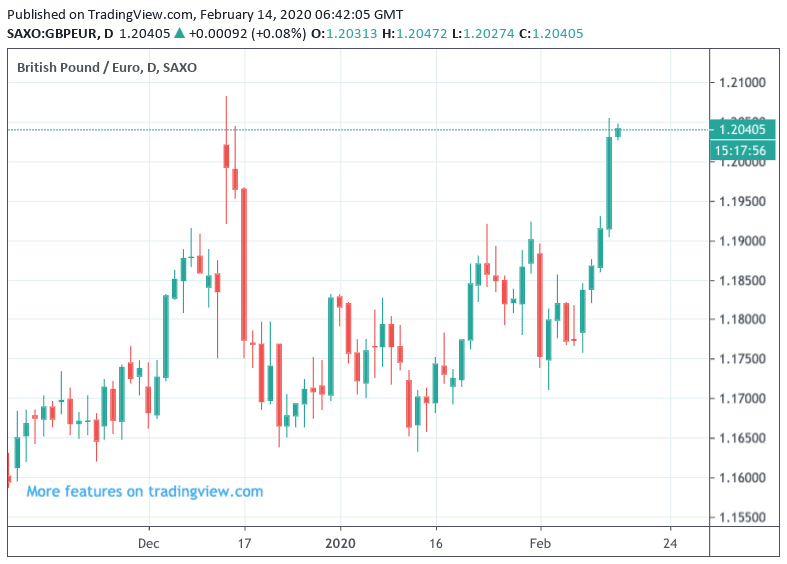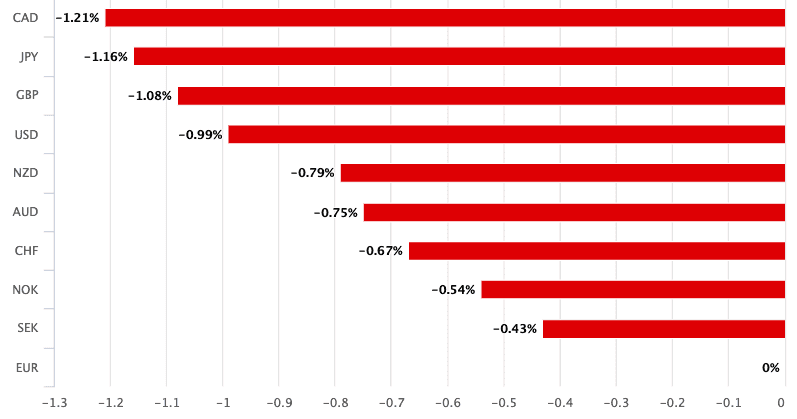
Euro Buyers see Best Exchange Rate Since mid-December as Pound Sterling Boosted by Expectations for Increased Govt. Spending under Sunak
by Gary Howes- Sunak tipped to oversee increased govt. spending
- GBP/EUR moves above 1.20
- GBP/EUR forecast at 1.29 by year-end at Capital Economics
- GBP/EUR spot rate at time of publication: 1.2040, a 2.31% rise this week
- Bank transfer rates (indicative): 1.1718-1.1800
- Specialist FX provider rates (indicative): 1.1900-1.1930 >> More information
The British Pound has advanced against the Euro for six months in a row now and the momentum has taken the GBP/EUR exchange rate back up to 1.20, offering those looking to buy Euros their best value since a brief period in December.
The jump in the Pound following the December General Election was however a brief one and questions will be asked as to whether the current bounce we are currently seeing will be equally as brief.
Sterling's gains comes amidst ongoing chronic weakness in the Euro, as well as political developments in the UK where Prime Minister Boris Johnson replaced the head of the Treasury leading foreign exchange markets to believe that a sizeable fiscal stimulus is coming that should prove supportive of economic growth and lessen the chance of a Sterling-negative interest rate cut being issued at the Bank of England.
"GBP/EUR records highest opening rate since June 2016," says George Vessey, Currency Strategist at Western Union, adding:
"GBP/USD spiked through the resistance level of $1.30 and pushed on to clip $1.3070. The big story comes from GBP/EUR, which jumped over 1% yesterday, pierced €1.20 and reached €1.2050 for only the third day in three years. Today, GBP/EUR has opened above €1.20 for the first time since June 30, 2016."
Sajid Javid has been replaced by Rishi Sunak as the Chancellor of the Exchequer, a move that has been described by some political commentators as being a power grab of the country's purse strings by Johnson's office.
Javid had sought commitments from Johnson towards achieving a balanced budget by 2022/23, "yet with him gone we now looking at a more expansionary fiscal stance to boost the economy through the current economic uncertainty," says Joshua Mahony, Senior Market Analyst at IG.
Sunak is young and relatively inexperienced when it comes to high governance and it is expected he will be more in tune with Johnson's plans for boosting spending in the upcoming March budget.
Neil Jones, Head of Institutional FX Sales at Mizuho Bank says he senses "the market is anticipating a more expansionary fiscal style chancellor waiting in the wings. With monetary policy potentially reaching the limits & possibly larger government spending ahead, Sterling would certainly benefit."
A boost in government spending would add to UK economic growth rates which would in turn be a fundamentally supportive development for the Pound.
"The surprise change of Chancellor... bolsters our view that looser fiscal policy and tighter monetary policy are on the way. In turn, this supports our forecasts for a stronger Pound," says Hubert de Barochez, Markets Economist with Capital Economics.

Of course, increases in spending must be judged to be credible by the markets and the Government will therefore not have free rein when it comes to turning on the taps at the Treasury. It is however worth noting the Sunak had during the campaign period leading to the General Election shown himself to be a strong advocate for maintaining fiscal balance and we therefore would anticipate a pragmatic approach to be maintained by the new Chancellor.
"A deficit-financed spending spree would risk raising the deficit to a level that would make the public sector finances vulnerable during the next downturn," says Kallum Pickering, Senior Economist at Berenberg. "Modest tax hikes to finance at least part of the planned spending can help to mitigate this risk."
Pickering notes Johnson had already legislated for the fastest growth in day-to-day government spending in 15 years.
"Expect a major step up in investment spending at the upcoming budget on 11 March. Fiscal stimulus could contribute 0.7ppt to headline GDP growth in 2020 and c0.3ppt in 2021," says Pickering.
The prospect of a Government stimulus to the economy will likely in turn convince the Bank of England that interest rates can remain stable at 0.75%, which should further allow market expectations for an interest rate cut to fade.
The rule of thumb in foreign exchange markets is that when expectations for interest rate cuts from a central bank fade, the currency that central bank issues rises in value.
Stable interest rates in the UK would contrast markedly to the Eurozone where the European Central Bank could cut interest rates as early as April or June according to economists at Credit Suisse. The divergence in interest rate policy would in turn prompt further GBP/EUR upside.
Capital Economics are forecasting the Pound-to-Euro exchange rate to end 2020 at 1.29, the highest forecast we have encountered amongst the analyst community.
However, we are aware that in currency markets nothing ever moves in a straight line and the prospect of tumultuous EU-UK trade deal talks should provide ample opportunity for Sterling weakness in the year ahead. "Despite the positive uplift in the pound, an uncertain and potentially turbulent future awaits as UK-EU trade talks also get underway next month. It’s unclear whether sterling will hold on to these recent gains, particularly against the Euro," says Vessey.
For now however, we are seeing the best Pound to Euro exchange rate for those looking to move money from Sterling into Euros.
Chronic Euro Weakness
The outlook for GBP/EUR remains tilted to the upside thanks to a long-term multi-month trend, positive political developments and due to expectations for further underperformance in the Euro.
Importantly, the move higher in the Pound-to-Euro exchange rate is also a story of Euro weakness; the Eurozone's single currency has come under a renewed bout of selling pressure over the course of the past 24 hours.
We are watching the Euro-Dollar exchange rate for clues as to how the Euro is performing, and we can see EUR/USD dropped to its lowest level since 2017, into the 1.08’s. This has been mirrored right across the Euro exchange rate complex.
If we look at how the Euro is performing against its other peers, we can see it is in fact the worst-performing major currency of the past week, helping to explain why the Pound has made progress.

What is bothering the Euro then? We would say the single most important factor contributing to weakness in the Euro is the coronavirus outbreak which is expected to have a notable impact on the Chinese economy.
China matters for the Eurozone as it is such an important trading partner, particularly as a destination for German exports. 2019 saw Germany's industrial sector fall into recession and the bet was a trade deal between the U.S. and China, reached at the end of the year, would herald a rebound in global trade and in turn boost the German economy.
2019 was supposed to be a year in which the Eurozone economy started to outperform, thereby pushing demand for the Euro higher. However, the coronavirus outbreak has put expectations for a growth rebound on ice and has ultimately delayed the Eurozone recovery.
We reported this week that Credit Suisse, the Swiss-based global investment bank, believes the European Central Bank will now cut interest rates by 10 basis points in an effort to try and stimulate the economy, taking the basic interest rate in the Eurozone down to -0.6%.
"Both direct (falling exports to Asia), and indirect (production affected by disrupted supply chains) effects will likely lead to a material fall in manufacturing surveys, such as the PMIs, in the months ahead, possibly of around 4-5 points. That’ll be especially true for Germany, which is highly exposed to both," says Neville Hill, Managing Director and Chief Economist Europe for the Investment Strategy and Research department at Credit Suisse in London.
"We would not underestimate the effects of supply chain disruption. Automakers in Japan, South Korea and Europe have already announced that shortages of components could, or have already, lead to suspended production," adds Hill.
Expectations are growing that the Eurozone's data for January and February 2020 will disappoint, something that will add to growing expectations for an ECB interest rate cut.
The general rule in foreign exchange circles is that when a central bank cuts interest rates, the currency it issues declines in value.
Therefore, should the market start anticipating a cut to the ECB's interest rate the Euro would be expected to fall. The move lower in the Euro suggests the market is already at advanced stages in pricing in another interest rate cut.
Credit Suisse expect the tone at the March ECB Governing Council meeting to be dovish, opening the door to a cut in April or June if the data are sufficiently weak.
Global Head of ITS Trading Strategy at Credit Suisse says the prospect of a rate cut at the ECB, "adds further fuel to our already-bearish EUR views. We see scope for EUR/USD 1.0650 and EUR/CHF 1.05 on a 3-month horizon. Softening euro area inflation expectations already hint in this direction."